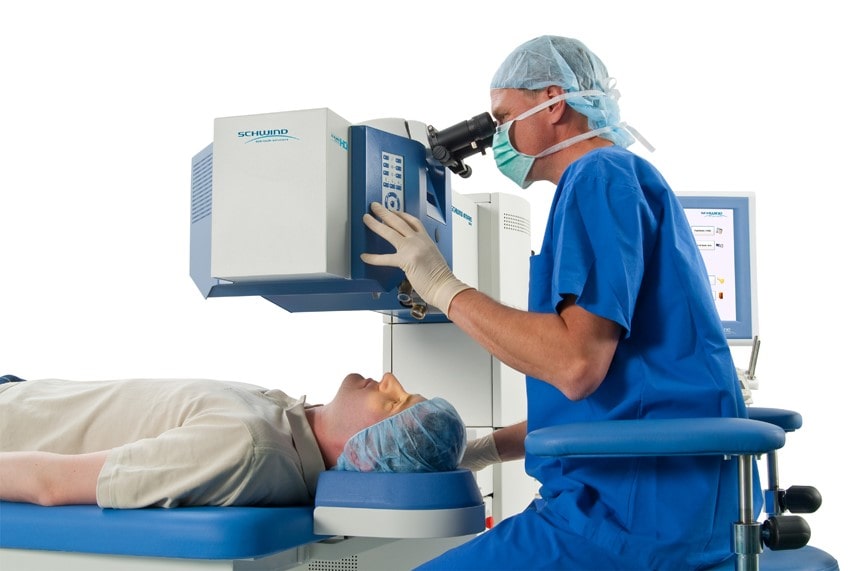Photorefractive keratectomy (PRK)

What you want to read...
What is Photorefractive keratectomy (PRK)?
Photorefractive keratectomy (PRK) is a type of laser eye surgery used to correct refractive errors in individuals with myopia (nearsightedness), hyperopia (farsightedness), and astigmatism. In this procedure, similar to LASIK but without creating a flap or lifting a corneal layer, a laser is used to directly reshape the corneal surface to correct vision. PRK is more suitable for people with thinner corneas or specific corneal conditions, as it does not involve creating a corneal flap. Additionally, PRK avoids potential complications associated with flap creation.
PRK is performed by removing the surface layer of the cornea, known as the epithelium, and then using a laser to reshape the cornea. This reshaping process helps to reduce the curvature of the cornea for correcting myopia, steepen the cornea for hyperopia, or create a more spherical shape for astigmatism correction.
PRK can be a suitable alternative to LASIK, especially for individuals with thinner corneas or specific corneal conditions. This procedure has the advantage of avoiding flap-related complications.
PRK Laser Surgery Technique
The majority of the stages in PRK laser surgery are similar to LASIK surgery; however, the significant difference is that in LASIK, after the removal of a layer of the cornea (flap), a certain amount of tissue from the middle part of the cornea is reshaped with the laser, while in PRK laser surgery, laser energy is applied directly to the surface of the cornea.
Before the surgery, a comprehensive medical and eye examination is performed. Accurate refraction measurement is conducted to determine the eye’s prescription. For more precise measurements, eye drops are also used. A specialized optical map called “topography” or “orb scan” is prepared to assess the corneal optical status. The corneal thickness is measured using a method called “pachymetry.”
During the surgery, the eyelids and the area around the eyes are disinfected with an antiseptic solution (usually Betadine). The operating room technician instills numbing eye drops and antibiotics into your eyes several times to ensure you won’t feel pain or discomfort during the procedure. Afterward, you lie on the operating table, and the surgical microscope is positioned in front of your face.
The laser eye surgery is performed under the effect of topical anesthesia eye drops that numb the surface of the eye (the conjunctiva and cornea).
For photorefractive keratectomy (PRK) surgery, is general anesthesia required, or is local anesthesia sufficient?
Laser eye surgery, including LASIK, is performed under the influence of local anesthesia administered through eye drops, which numbs the surface of the eye (the conjunctiva and the cornea).
Advantages of Photorefractive Keratectomy (PRK)
- PRK is more suitable for low to moderate levels of myopia, hyperopia, and astigmatism.
- The duration of PRK surgery is generally shorter compared to LASIK.
- The complications associated with flap creation, such as deep lamellar keratitis (DLK), wrinkles and folds in the flap, and flap dislocation, are not present in PRK because PRK does not involve creating a flap in the cornea.
- There is no complete flap, partial flap, and so on in PRK.
- PRK does not require a microkeratome and related technology.
Recommendations and Preparations Before Photorefractive Keratectomy (PRK) Surgery
- Do not use cosmetics around the eyes a few days before and after the surgery.
- Contact lenses should not be used before surgery. Soft contact lenses should be discontinued one week before the surgery, and hard contact lenses should be discontinued three weeks before the surgery.
- It's important to inform your doctor if you are taking any medications, have any medical conditions, are pregnant, or breastfeeding.
- Avoid wearing perfume or cologne on the day of your surgery as it can leave residues on the surgical equipment.
- Increased cooperation during surgery can improve the chances of a successful procedure.
- If needed, you can take a 5mg diazepam tablet about half an hour before the surgery to help reduce your anxiety.
Recommendations During Photorefractive Keratectomy (PRK) Surgery
- This surgery is performed under local anesthesia using eye drops.
- Avoid blinking and moving your head during the procedure.
- Look at the red light blinking and try not to move your eye.
Post-Operative Care After Photorefractive Keratectomy (PRK) Surgery
After the operation, you will have several follow-up appointments with your doctor. During these visits, your protective lens will be removed. You may experience some burning, tearing, discomfort, and blurry vision for a few days after the surgery. This is normal and your vision will gradually improve over time. It’s essential to get plenty of rest. Avoid rubbing your eyes for a month, and refrain from using eye makeup for two weeks. Do not let water get into your eyes for a day after the operation, and avoid swimming for four weeks. Wearing sunglasses on sunny days in the weeks following the surgery is recommended. Changes in your vision, such as blurriness, are normal after the surgery and will gradually resolve.
